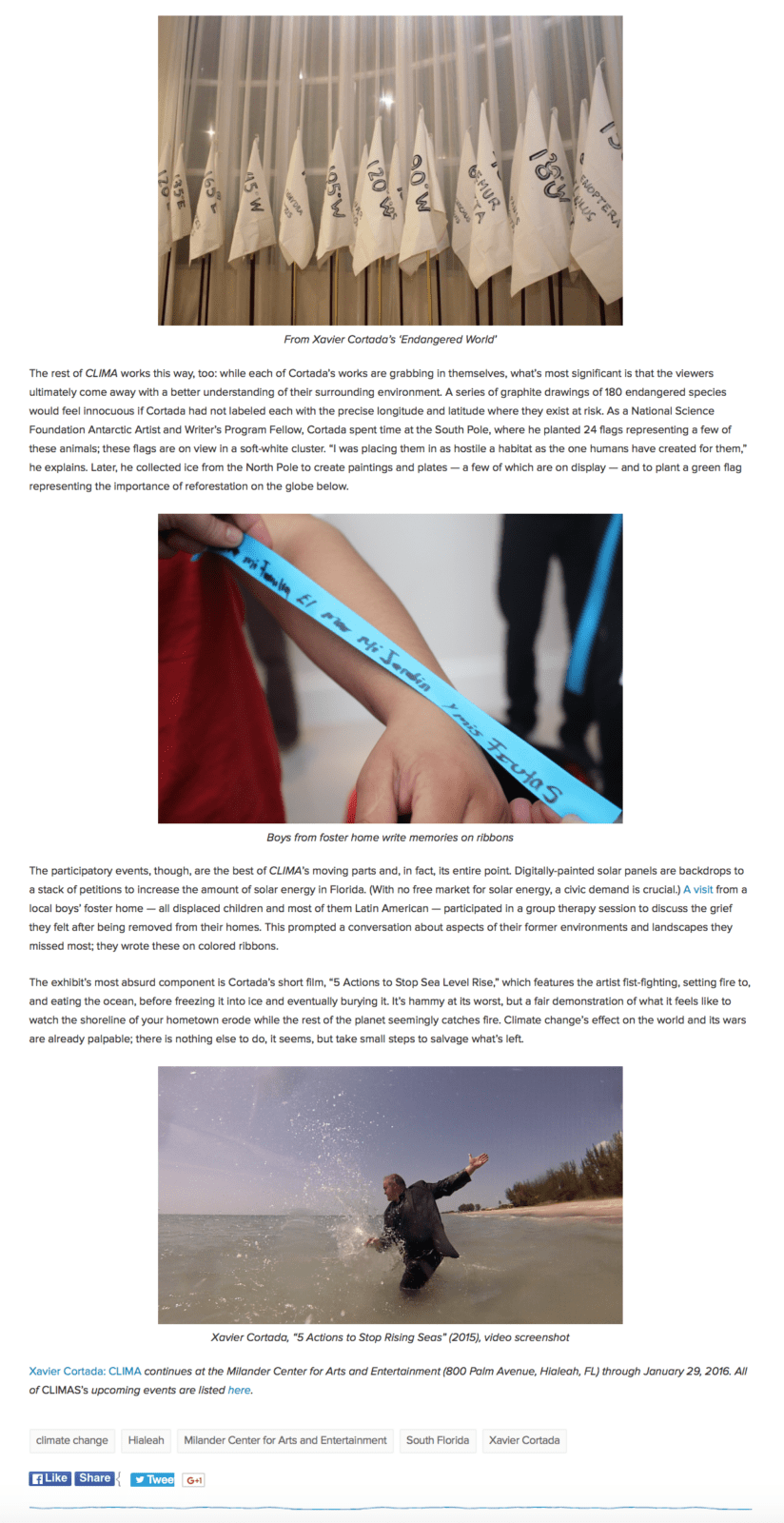
HYPERALLERGIC
Interactive Art About Climate Change in a City Where It Will Wreak Havoc
by Monica Uszerowicz on December 11, 2015

HIALEAH, Fla. — When Florida Governor Rick Scott took office in 2011 and appointed Herschel Vinyard, Jr. as the director of the Florida Department of Environmental Protection(D.E.P.), a curious rule went into effect: D.E.P. employees were not to use the terms “global warming” or “climate change” in any official communications. Though this revelation came from the Florida Center for Investigative Reporting, spokespeople for Scott have vehemently denied the claim. The reality is that it doesn’t really matter either way: semantics alone don’t account for climate change denial — especially in South Florida, where sea-level rise is conspicuous and the state-approved actions to work with it are often negligible.
Xavier Cortada, the artist-in-residence for Florida International University’s College of Arts & Sciences’ School of Environment, Arts, and Society, makes interactive art that merges with, or calls attention to, environmental science. He often employs the research of fieldworkers to draw attention to poignant environmental and biological themes — like synthesizing an actual DNA strand made from sequences generated by participants, or collaborating with botanists to reforest mangroves. Utilizing the arts as a platform for environmental consciousness can be noble, and it’s even better when there’s a component of real activism.
Cortada’s current exhibition, CLIMA, functions as both archival retrospective and venue for social change. CLIMA is exhibited in Hialeah, a city bordering Miami where, if sea levels were to rise just four feet, 70% of the population would be flooded. The first few days of CLIMA run concurrent to the Paris climate talks, during which a plan for the reduction of carbon emissions may be reached. In response, Cortada has created a series of performances and accompanying talks to address different facets of global climate change, particularly rising sea levels.

Panelists have thus far come from a range of disciplines, from Colin Foord of the science and art project Coral Morphologic to the Superintendent of Miami-Dade County Public Schools, Alberto Carvalho, who discussed creating “greener” curriculums for schools. This week, Cortada had a group of junior high school children participate in a spelling bee in which they were asked to spell the names of pesticides found in fertilizers and other products. Asking children to recite these chemicals, the artist explains, enacts the cyclical nature of environmental degeneration, making clear that our own lives are not separate from our ecosystem’s. “What you pour down your drain or put in your garden,” he says, “all have consequences. When birds eat intoxicated fish, they become ill, too. These children are the victims affected by the very chemicals they’re naming.” Most of the kids could not spell things like “monopotassium phosphate” or “potassium sulfate.”
Following the spelling bee, Cortada urged the students to write “letters of repentance” to the environment — promises for change — and set them at the feet of a surprisingly at-ease pelican named Pepe. The work seemed less focused on the performance itself than on encouraging children to think about their own environmental impact.

The rest of CLIMA works this way, too: while each of Cortada’s works are grabbing in themselves, what’s most significant is that the viewers ultimately come away with a better understanding of their surrounding environment. A series of graphite drawings of 180 endangered species would feel innocuous if Cortada had not labeled each with the precise longitude and latitude where they exist at risk. As a National Science Foundation Antarctic Artist and Writer’s Program Fellow, Cortada spent time at the South Pole, where he planted 24 flags representing a few of these animals; these flags are on view in a soft-white cluster. “I was placing them in as hostile a habitat as the one humans have created for them,” he explains. Later, he collected ice from the North Pole to create paintings and plates — a few of which are on display — and to plant a green flag representing the importance of reforestation on the globe below.

The participatory events, though, are the best of CLIMA’s moving parts and, in fact, its entire point. Digitally-painted solar panels are backdrops to a stack of petitions to increase the amount of solar energy in Florida. (With no free market for solar energy, a civic demand is crucial.) A visit from a local boys’ foster home — all displaced children and most of them Latin American — participated in a group therapy session to discuss the grief they felt after being removed from their homes. This prompted a conversation about aspects of their former environments and landscapes they missed most; they wrote these on colored ribbons.
The exhibit’s most absurd component is Cortada’s short film, “5 Actions to Stop Sea Level Rise,” which features the artist fist-fighting, setting fire to, and eating the ocean, before freezing it into ice and eventually burying it. It’s hammy at its worst, but a fair demonstration of what it feels like to watch the shoreline of your hometown erode while the rest of the planet seemingly catches fire. Climate change’s effect on the world and its wars are already palpable; there is nothing else to do, it seems, but take small steps to salvage what’s left.

Xavier Cortada: CLIMA continues at the Milander Center for Arts and Entertainment (800 Palm Avenue, Hialeah, FL) through January 29, 2016. All of CLIMAS’s upcoming events are listed here.

